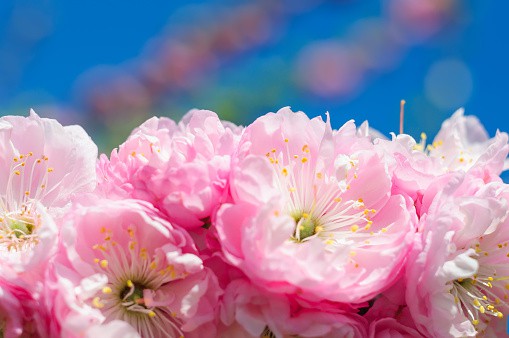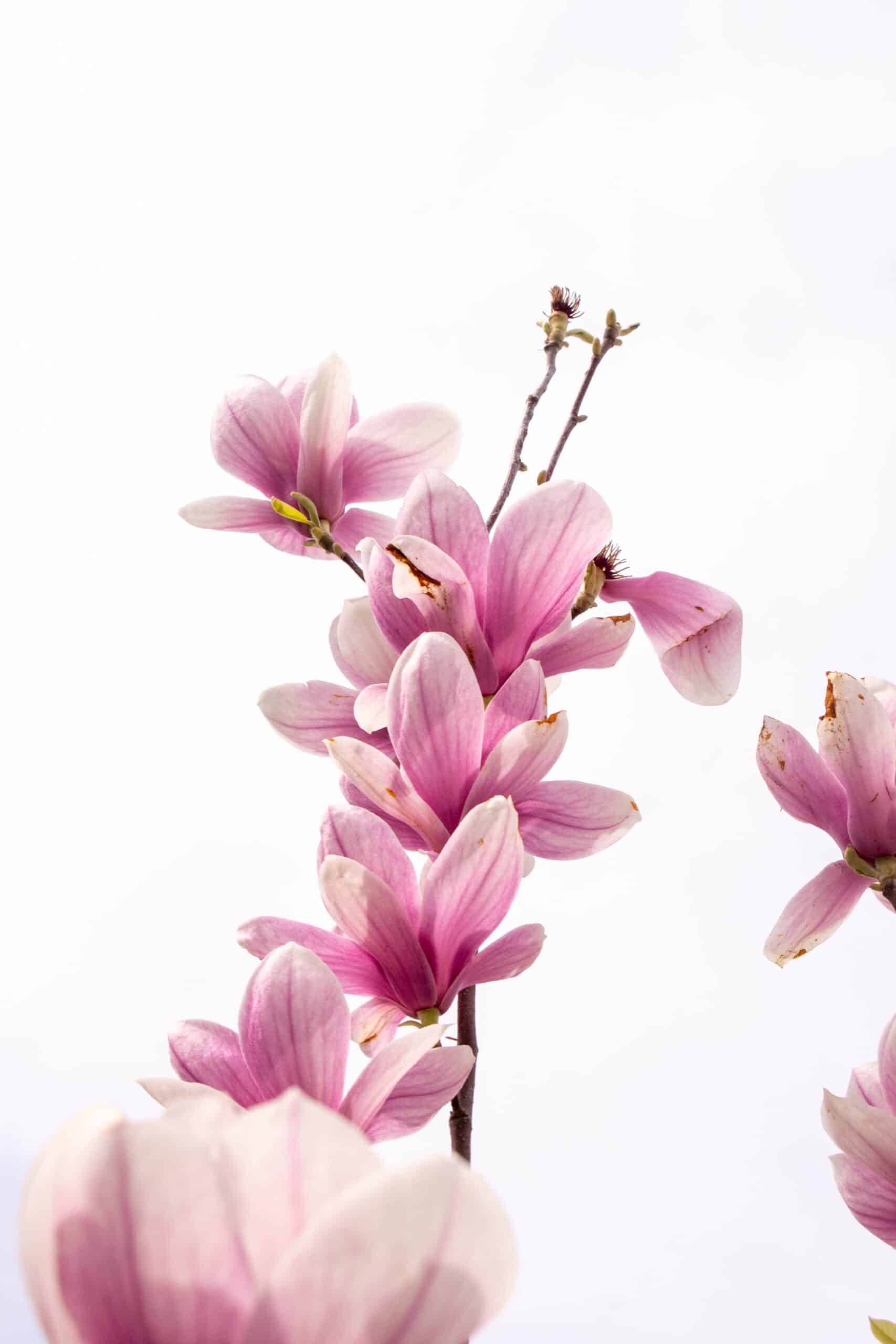Pink flowering almond, or Prunus triloba, is a shrub that sometimes grows into a small tree. It is often adorned with beautiful white to pale pink flowers with long delicate stamens, almost as if they were made to fit the scenery perfectly. It’s a magnificent sight to behold in full bloom, and its native land of China is popularly dotted with these beautiful pink-flowering almonds, as well as in other parts of the world. The stones produced in the fall are often used to make beaded bracelets, which could be an added bonus for curious homemade jewelry makers and crafters.
Etymology of Prunus Triloba
The name Prunus Triloba, meaning “three-lobed”, refers to the leaves of the plant, which fan out from a center point and are divided into three lobes. This type of leaf making can be seen on a variety of trees and plants, and are prominently known for their even lobes and symmetry. The pink flowering almond has an alternate common name, Wild Balsam, derived from the Latin family name for the species, BALSAMINACEAE.
How to Plant
Pink flowering almonds should be planted in well-drained soil and in a location that gets adequate, but indirect, sunlight. It is important to prepare the soil beforehand by aerating, weeding and adding a layer of compost to help create an optimal setting for planting. The ideal temperature and pH levels of the soil should be between 6-7, and the surrounding atmosphere should have moderate humidity. Although pink flowering almonds do not require excessive watering, providing about 1.5 – 2 inches of water per week is necessary for optimal growth. It is also recommended that the planting site be fertilized annually with a low-nitrogen fertilizer specifically tailored for flowers. Lastly, if creating a boxed-garden, the box should be tall and wide enough to provide ample space for the spreading roots.
Meaning and Symbolism
Pink flowering almonds are rich in symbolism with its many meanings. Pink is a color of gentleness and beauty, and the almond itself is a symbol of faith, promise, and new wonder. In Chinese symbolism, it is believed that pink flowering almonds can bring strength, good health and prosperity; the flower’s impressive ability to endure difficult conditions and illustrate gentleness, resilience and joy are all traits that people can use to understand life’s struggles. Thus, pink flowering almonds is a beautiful source of growth and insight.
History, Mythology and Religious Significance
Pink flowering almonds have had a long and revered history in Chinese culture. It was first referenced in Chinese poetry as early as the Tang Dynasty (618-907), and its representation in paintings dates back to the Song Dynasty (907-1280). In the poem “Returning Home at the Water Pavilion” by Liu Yuxi, the almond is used as a metaphor for many topics, ranging from lost love to the beauty of integrity. In religious contexts, pink flowering almond is a symbol of consolation for early Christian martyrs, and Buddhists have come to use it as a physical representation of wisdom and purity. In modern times, pink flowering almonds are a holy symbol of Christmas in many countries, and continue to represent hope, joy and happiness.
Flower Varieties and their Defining Characteristics
There are different varieties of pink flowering almond, some with subtle differences, while others yielding more distinct distinctions. The most popular varieties of Prunus Triloba are:
- Prunus triloba ‘Double Pink’ – This variety of Prunus triloba is noted for its strong production of double-formed flowers, which appear in pink.
- Prunus triloba ‘Maule’s Prolific’ – The flowers of Maule’s Prolific are born in larger clusters than non-fruiting varieties, and they are also a little bigger.
- Prunus triloba ‘Weeping’ – This variety is classified by its clusters of soft pink, weeping flowers, which appear in the spring and last until the beginning of summer.
- Prunus triloba ‘Multiplex’ – The striking feature of the Multiplex variety of Prunus triloba is its abundance of flowers, which are of a soft pink.
- Prunus triloba ‘Pink Perfection’ – Compact and low-growing, this variety bears a profusion of elegant and deep pink flowerets in the spring, and stays more newly shaped than other varieties.
How to Pot and Repot
When potting pink flowering almonds, it’s important to select a planter that has plenty of room for growth. The planter should also have large drainage holes for water to flow out of, as in their natural environment, the roots of pink flowering almond plants will always have a warm atmosphere and water to drink. When selecting soil, choose something that has plenty of organic matter, such as potting soil mixed with compost. When potting the plant, make sure to lightly break up the roots to allow the plant to spread out, unless replanting or refreshing an existing pot. When it comes to repotting, it’s best to choose a larger planter and to use fresh soil with the same water, light and fertilizer specifications as the original pot.
How to Prune
Pruning pink flowering almond shrubs is essential for encouraging more healthy and abundant flowering. It’s best to prune and shape the shrub in early spring, as this encourages the most flower production. To do so, first examine the shrub, looking for any damaged or dead branches that need to be removed. Trim the branches by a few inches, as this allows the bud to form at the base, which in turn will create a more unified shape. As a general rule, prune to just above the bud while keeping the plant healthy and balanced. In terms of ornamental shaping of the shrub, prune to allow the tree to show its natural beauty.
How to Propagate
Propagating pink flowering almonds is relatively easy and straightforward. Cuttings from mature plants can be taken and preserved in a cool and dry area for about a week in order for the wound to heal and prevent fungal diseases. Once the cuttings are ready for planting, it is important to select an area with indirect light and high humidity, and to keep the plants in an area of 70-85 degrees Fahrenheit. When it comes to soil, use a mixture of peat moss and perlite or sand to optimize drainage while still allowing the plant to absorb enough water. Lastly, lightly sprinkle a small amount of fertilizer on top of the soil.
Common Pests and Diseases
Pink flowering almonds can be affected by a few common pests, such as aphids, spider mites and scale. The pests can be removed by using an insecticidal soap or neem oil spray. Plants can also be affected by various fungal diseases, such as powdery mildew and leaf spot, which can be prevented by providing the ideal growing conditions for the plant. Watering the shrub in the morning and avoiding overcrowding can help mitigate the risk of disease. When dealing with fungal diseases, it is important to act quickly, as the disease can quickly spread to neighboring plants.
Frequently Asked Questions
Q: Where is Prunus Triloba from?
A: Prunus Triloba is native to China, but is also popular around the world.
Q: What color are Prunus Triloba flowers?
A: Prunus Triloba flowers are usually white to a pale pink color.
Q: What is the best location for planting Prunus Triloba?
A: Prunus Triloba should be planted in a spot that gets adequate but indirect sunlight.
Table Fact Sheet
| Name | Description |
|---|---|
| Pink Flowering Almond | Prunus Triloba |
| Family | Rosaceae |
| Plant Type | Perennial |
| Mature Size | 3–6 feet tall, 3–4 feet wide |
| Sun Exposure | Partial Sun/Full Shade |
| Soil Type | Well-drained |
| Soil pH | 6-7 |
| Bloom Time | Spring, Summer |
| Flower Color | White to Pale Pink |
| Hardiness Zones | 4–8 |
| Native Area | China |
What we love from Amazon this week
Buy these wonderful flowers directly from Amazon:















